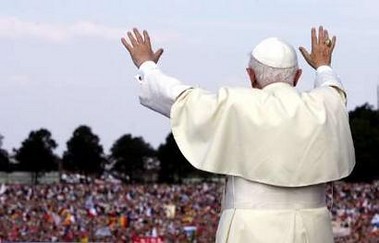Sentire cum Ecclesia sub Petre

This Sunday's Liturgy presents the classic account in St Matthew's Gospel of the Commissioning of St Peter as leader of the Church established by Christ. Anyone who has been to St Peter's Basilica in Rome will see the central phrase: "You are Peter, and upon this rock I will build my church" emblazoned in Latin around the interior drum of Michelangelo's great dome. In that same church, a bronze statue of St Peter, seated on a throne and much venerated holds the great keys alluded to by Christ, a symbol of authority. The Readings that surround the Gospel also focus on this central pericope. Isaiah 22:19-23 recounts the establishment of Eliakim as viceroy and uses imagery and language that mirrors the account in Matthew 16:13-20. But St Paul's letter to the Romans reminds us that God has no equal or any truly worthy viceroy; all glory belongs to Him.
These leitmotifs of today's Liturgy is familiar to all Catholics and I don't think I need dwell upon them. Instead, I offer the painting above by Perugino from the Sistine Chapel and the following from one of my favourite books, 'The Splendor of the Church' by Henri Cardinal de Lubac, SJ. In this chapter (7), De Lubac writes beautifully of the qualities of a man of the Church, the vir Ecclesiae; it is a paean to the Christian who strives to think with the Church in union with Peter. To each of us, Christ also asks: "Who do you say that I am?" and we are invited to respond with St Peter, "You are the Christ, the Son of the Living God."
Thus, Cardinal De Lubac says:
"It is primarily of [the Roman Church] that the Catholic thinks when he calls the Church his Mother. In common with tradition, he considers her as 'root and Mother of the Catholic Church', as 'the Mother and mistress of all the Churches', as 'Mother and mistress of all the faithful of Christ'. He considers her head [the Pope] as 'the head of the episcopate' and the 'father of the Christian people', 'the master of the whole household of Christ', as St Ignatius Loyola puts it... He knows that Peter was given the charge of not only the lambs but the sheep as well; that Christ himself prayed that the faith of Peter might not fail; and that he gave Peter the keys of the Kingdom of Heaven and the command to confirm his brethren. He realizes that Peter personifies the whole Church and that just as each bishop is the bridegroom of his own particular Church, so Peter, the Bishop of Rome, may be said to be the bridegroom of the Universal Church, the whole of which has in him its visible foundation. As against a frequently lodged objection (based on a misunderstanding), he will, of course, be equally clear that this visible foundation in no way prejudices that unique Foundation which is Christ, any more than the visible chief shepherd puts into eclipse the Good Shepherd, since here there is no question of duplication, the very name 'Peter' having been chosen by Christ to express this identity of submission, which is in itself the fruit of faith. Believing as he does that the Church has received the promise of perpetuity and victory over death, and holding that it was she who was in Christ's mind in that scene on the road to Caesarea, he will naturally grasp the consequence that as long as the Church goes on building herself up and subsisting in her visible state - that is to say, as long as the world lasts - she cannot be without a visible foundation for her building. Peter was not given his office simply in order to relinquish it almost at once; he was given it to hand on after him. In his successors - the bishops of the See of Rome, which was founded by him and consecrated by his blood - he lives, presides and judges perpetually... He will always see in Peter both the unshakeable rock upon which his own firmness is based and the 'center of Catholic truth and unity', the one and only visible center of all the children of God. In the authority of Peter he sees the support of his faith and the guarantee of his communion. And thus his fidelity to the Christian faith finds concrete expression in his love for Peter, to whom he is bound, despite all exterior vicissitudes, by every fiber of his soul."

It is for this reason that almost a million young people are now gathered in Cologne on the banks of the Rhine around Pope Benedict XVI, the successor of Peter, to celebrate their common faith that Christ is the Son of the Living God and in Him alone is the fullness of life and salvation.
As the Holy Father himself told the young people on Thursday: "To all of you I appeal: Open wide your hearts to God! Let yourselves be surprised by Christ! Let him have "the right of free speech" during these days! Open the doors of your freedom to his merciful love! Share your joys and pains with Christ, and let him enlighten your minds with his light and touch your hearts with his grace. In these days blessed with sharing and joy, may you have a liberating experience of the Church as the place where God's merciful love reaches out to all people. In the Church and through the Church you will meet Christ, who is waiting for you."
That too is his invitation to us as we celebrate this Sunday's Liturgy and we encounter the Son of the Living God present in the Eucharist.







0 Comments:
Post a Comment
<< Home